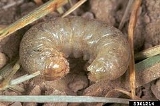
Agrotis orthogonia
Encyclopedia
The Pale Western Cutworm (Agrotis orthogonia) is a moth
of the Noctuidae
family. It is found in North America
, more specifically dry, semi-desert areas of western North America from southern Canada
to California
, ranging eastward nearly to the eastern edge of the Great Plains
.
The wingspan
is about 34 mm.
The larvae feed on various forbs and grasses. The species is occasionally of economic importance on winter wheat and small grains. It has also been reported from corn and sugar beets.
Moth
A moth is an insect closely related to the butterfly, both being of the order Lepidoptera. Moths form the majority of this order; there are thought to be 150,000 to 250,000 different species of moth , with thousands of species yet to be described...
of the Noctuidae
Noctuidae
The Noctuidae or owlet moths are a family of robustly-built moths that includes more than 35,000 known species out of possibly 100,000 total, in more than 4,200 genera. They constitute the largest family in the Lepidoptera....
family. It is found in North America
North America
North America is a continent wholly within the Northern Hemisphere and almost wholly within the Western Hemisphere. It is also considered a northern subcontinent of the Americas...
, more specifically dry, semi-desert areas of western North America from southern Canada
Canada
Canada is a North American country consisting of ten provinces and three territories. Located in the northern part of the continent, it extends from the Atlantic Ocean in the east to the Pacific Ocean in the west, and northward into the Arctic Ocean...
to California
California
California is a state located on the West Coast of the United States. It is by far the most populous U.S. state, and the third-largest by land area...
, ranging eastward nearly to the eastern edge of the Great Plains
Great Plains
The Great Plains are a broad expanse of flat land, much of it covered in prairie, steppe and grassland, which lies west of the Mississippi River and east of the Rocky Mountains in the United States and Canada. This area covers parts of the U.S...
.
The wingspan
Wingspan
The wingspan of an airplane or a bird, is the distance from one wingtip to the other wingtip. For example, the Boeing 777 has a wingspan of about ; and a Wandering Albatross caught in 1965 had a wingspan of , the official record for a living bird.The term wingspan, more technically extent, is...
is about 34 mm.
The larvae feed on various forbs and grasses. The species is occasionally of economic importance on winter wheat and small grains. It has also been reported from corn and sugar beets.

